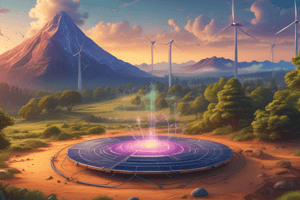Podcast
Questions and Answers
What type of energy is stored in batteries and then converted to light energy in a flashlight?
What type of energy is stored in batteries and then converted to light energy in a flashlight?
- Radiant energy
- Chemical energy (correct)
- Mechanical energy
- Electrical energy
What type of energy from the Sun gets converted into chemical energy (glucose) by plants during photosynthesis?
What type of energy from the Sun gets converted into chemical energy (glucose) by plants during photosynthesis?
- Mechanical energy
- Radiant energy (correct)
- Electrical energy
- Thermal energy
Which type of energy from the movement of windmill blades gets converted to electrical energy?
Which type of energy from the movement of windmill blades gets converted to electrical energy?
- Mechanical energy (correct)
- Thermal energy
- Chemical energy
- Light energy
What type of energy from the wall outlet gets converted to mechanical energy that makes the fan blades of a table fan move?
What type of energy from the wall outlet gets converted to mechanical energy that makes the fan blades of a table fan move?
In a microwave oven, what form of energy from the wall outlet gets converted to electromagnetic energy that then becomes heat energy?
In a microwave oven, what form of energy from the wall outlet gets converted to electromagnetic energy that then becomes heat energy?
Flashcards are hidden until you start studying
Study Notes
Energy Conversion
- Energy is the ability to do work or produce change.
- There are many different types of energy, including mechanical, radiant, chemical, electrical, thermal, and sound energy.
Energy Conversion Process
- Energy can be converted from one form to another, known as Energy Conversion or Energy Transformation.
- Example: when a person eats an apple, they get chemical energy stored in that apple, which is converted to mechanical energy when they move.
The Law of Conservation of Energy
- The Law of Conservation of Energy states that energy is neither created nor destroyed.
- Energy can change form, but the total amount of energy in the universe remains constant.
- Example: in a windmill farm, mechanical energy is converted to electrical energy.
The First Law of Thermodynamics
- The Law of Conservation of Energy leads to the First Law of Thermodynamics.
- The First Law states that the total energy of a system remains constant, even when one form of energy is converted to another form.
Types of Energy Conversion
- All forms of energy can be classified as either kinetic or potential.
- Kinetic energy is the energy of motion, due to the movement of waves, electrons, atoms, and objects.
- Potential energy is stored energy, or energy due to position.
Types of Potential Energy
- There are four types of potential energy:
- Chemical Potential Energy: energy stored in atomic bonds (e.g. energy stored in food).
- Elastic Potential Energy: energy stored in objects due to application of force (e.g. energy stored in a coiled spring or stretched rubber band).
- Gravitational Potential Energy: energy stored due to the position of an object (e.g. energy of a book on a bookshelf).
- Nuclear Potential Energy: energy stored in the nuclei of atoms (e.g. nuclear power plants).
Types of Kinetic Energy
- There are five types of kinetic energy:
- Electrical Energy: energy due to the motion of electrons (e.g. a smartphone plugged into a wall outlet).
- Radiant Energy (Light Energy): energy due to the motion of light waves (e.g. the Sun's energy reaches Earth through light waves).
- Thermal Energy (Heat Energy): energy due to the motion of atoms (e.g. a toaster producing heat).
- Sound Energy: energy due to the vibration of the medium (e.g. a guitar producing sound).
- Mechanical Energy: energy due to the motion of objects (e.g. a moving truck).
Real-Life Examples
- Any form of energy can be converted into any other form of energy.
- Examples of energy conversion can be seen almost everywhere, and multiple energy conversions can occur in sequence.
Studying That Suits You
Use AI to generate personalized quizzes and flashcards to suit your learning preferences.





